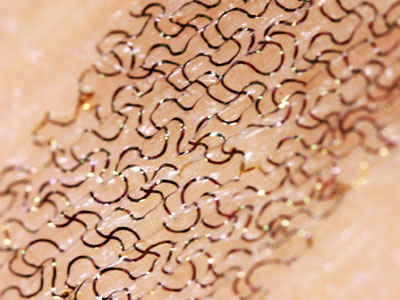Researchers Create Tattoo Electronics For Medical Applications
Researchers from Northwestern University and the University of Illinois at Urbana-Champaign have developed “tattoo electronics” -- wireless electronics so flexible and thin they can be applied to the skin and forgotten.
“The blurring of electronics and biology is the key point here,” said Yonggang Huang, who led the theory and design work at Northwestern. “All established forms of electronics are hard, rigid. Biology is soft, elastic. It’s two different worlds. We found a way to truly integrate them.”
The high-performance epidermal electronic system mounts directly onto the skin with the ease, flexibility and comfort of a temporary tattoo. The system could be used for monitoring brain, heart and muscle tissue activity; wound measurement and treatment; biological and chemical sensing; computer gaming and covert communications.
The study will be published in the Aug. 12 issue of the journal Science.
“The electronics can be seen but not felt,” said Huang, the Joseph Cummings Professor of Civil and Environmental Engineering and Mechanical Engineering at Northwestern’s McCormick School of Engineering and Applied Science. “Human skin is rough, but our electronics are able to follow the skin morphology and adhere like a temporary tattoo.”
The challenge for Huang and his colleagues was to make the thickness and stiffness of the electronic system similar to that of skin. The researchers accomplished this through a serpentine design of electronic nanoribbons.
The circuits for the various components are fabricated as tiny, squiggled wires. When mounted on lightweight and stretchable membranes, the wavy, snakelike shape allows the wires to bend, twist, scrunch and stretch while maintaining functionality.
The electronics also can be removed easily. They adhere to the skin the same way it is believed a gecko’s foot adheres temporarily to a surface: through an electrostatic phenomenon called the van der Waals force. Tape or glue is not necessary.
The system features electrophysiological and physical sensors and wireless power and communication modules. It is free of cumbersome wires, making it practical for use outside a research lab or clinic, in a natural environment.
“We threw everything in our bag of tricks onto that platform, and then added a few other new ideas on top of those, to show we could make it work,” said John Rogers, the Lee J. Flory-Founder professor of engineering at the University of Illinois at Urbana-Champaign.
Rogers, the paper’s corresponding author, led the design, experimental and fabrication work. Todd P. Coleman, assistant professor of electrical and computer engineering at the University of Illinois and an author of the paper, led the electroencephalogram (EEG), electrocardiogram (ECG) and electromyogram (EMG) work.
 In the study, the researchers show that their system’s EEG, ECG and EMG recordings are comparable to signals collected using bulky commercial devices that require tape for mounting to the skin.
In the study, the researchers show that their system’s EEG, ECG and EMG recordings are comparable to signals collected using bulky commercial devices that require tape for mounting to the skin.
They also demonstrate their system’s potential for use in human-machine interfaces. The electronics can be mounted on a person’s throat and, after training, the system can translate the simple spoken commands “up,” “down,” “left” and “right” into directions to control the video game Sokoban.
This capability could prove useful to patients with muscular or neurological disorders, such as amyotrophic lateral sclerosis, or ALS, who could use the electronic patches to communicate or interface with computers.
Another demonstration shows the electronics can be integrated with commercially available temporary tattoos, if there is a desire to conceal the electronics.
“We think this could be an important conceptual advance in wearable electronics, to achieve something that is almost unnoticeable to the wearer,” Coleman said. “The technology can connect you to the physical world and the cyberworld in a very natural way that feels very comfortable.”
The researchers used simple adaptations of techniques used in the semiconductor industry, so the patches are easily scalable and manufacturable.
The National Science Foundation and the Air Force Research Laboratory supported the research.
The paper is titled “Skin-Mounted, Multifunctional Electronics With Elastic Moduli Matched to the Epidermis.” In addition to Huang, Rogers and Coleman, other authors of the paper are Shuodao Wang, Jian Wu and Ming Li, of Northwestern University; Dae-Hyeong Kim, Nanshu Lu, Rui Ma, Yun-Soung Kim, Rak-Hwan Kim, Sang Min Won, Ahmad Islam, Ki Jun Yu, Tae-il Kim, Raeed Chowdhury, Ming Ying, Lizhi Xu, Hyun-Joong Chung, Martin McCormick and Hohyun Keum, of the University of Illinois at Urbana-Champaign; Hu Tao and Fiorenzo G. Omenetto, of Tufts University; and Ping Liu and Yong-Wei Zhang, of the Institute of High Performance Computing, Singapore.
- Megan Fellman, University Relations. Video by Matt Paolelli.